
Weevils are beetles belonging to the superfamily Curculionoidea, known for their elongated snouts. They are usually small, less than 6 mm in length, and herbivorous. Approximately 97,000 species of weevils are known. They belong to several families, with most of them in the family Curculionidae. It also includes bark beetles, which while morphologically dissimilar to other weevils in lacking the distinctive snout, is a subfamily of Curculionidae. Some other beetles, although not closely related, bear the name "weevil", such as the biscuit weevil, which belongs to the family Ptinidae.

The New Zealand giraffe weevil, Lasiorhynchus barbicornis, is a distinctive straight-snouted weevil in the subfamily Brentinae, endemic to New Zealand. L. barbicornis is New Zealand's longest beetle, and shows extreme sexual dimorphism: males measure up to 90 mm, and females 50 mm, although there is an extreme range of body sizes in both sexes. In males the elongated snout can be nearly as long as the body. Male giraffe weevils use this long rostrum to battle over females, although small males can avoid conflict and 'sneak' in to mate with females, sometimes under the noses of large males. The larval weevils tunnel into wood for at least two years before emerging, and live for only a few weeks as adults.
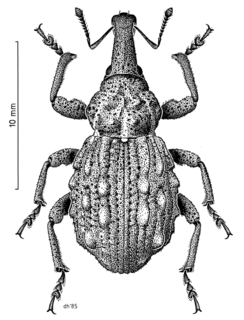
Hadramphus tuberculatus is a rare weevil endemic to Canterbury in the South Island of New Zealand. It was thought to be extinct in 1922 but was rediscovered in 2004.

The Cromwell chafer beetle is a species of flightless beetle in the family Scarabaeidae. It is found in just one spot in Central Otago, New Zealand, which is now a nature reserve.

The Entiminae are a large subfamily in the weevil family Curculionidae, containing most of the short-nosed weevils, including such genera as Entimus, Otiorhynchus, Phyllobius, Sitona, and Pachyrrhynchus. In comparison with their stunning diversity, only a few of these weevils are notorious pests of major economic importance. Entimines are commonly encountered in the field, including urban environments, and abundant in entomological collections.

Hadramphus, commonly known as knobbled weevils, is a genus of flightless molytine weevils from the family Curculionidae. It is endemic to New Zealand and consists of four species.
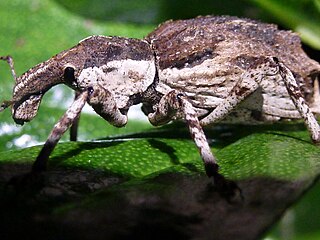
Anagotus stephenensis, commonly known as the ngaio weevil, is a large flightless weevil that is only found on Stephens Island in New Zealand. The ngaio weevil was discovered in 1916 by A.C. O'Connor on Stephens Island. Thomas Broun described it in 1921 as Phaeophanus oconnori after its collector. The weevils were observed at the time to be 'feeding on tall fescue and the leaves of trees'.

Anagotus fairburni or flax weevil is a large flightless weevil. It feeds on leaves of New Zealand flax species where it produces a characteristic feeding notch. It is found on islands and in alpine areas of New Zealand.

Apoderus coryli, common name hazel-leaf roller weevil, is a species of leaf-rolling beetles belonging to the family Attelabidae subfamily Attelabinae. Because of the trunk-like elongated head, it is often mistakenly attributed to the weevils.

Geodorcus helmsi,New Zealand giant stag beetle or Helms's stag beetle is a large, slow-moving, flightless stag beetle in the family Lucanidae. It is endemic to New Zealand.

Hypera postica, commonly known as the alfalfa weevil, is a species of beetle in the superfamily Curculionoidea; it can be found in alfalfa fields throughout Europe. Considered a destructive threat to alfalfa production in North America, several accidental introductions have been successfully countered though the use of a variety of biological control species.
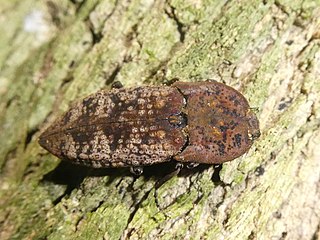
Amychus granulatus, commonly known as the Cook Strait click beetle, is a large flightless click beetle in the family Elateridae.

Hadramphus spinipennis, commonly called the coxella weevil, is a large, nocturnal, flightless weevil only found on Mangere and Rangatira Islands in the Chatham Islands, New Zealand.

Hypera nigrirostris, commonly known as the lesser clover leaf weevil, is a species of weevil that is native to Europe and northern Africa and has been introduced to North America and Japan. Both adults and larvae feed on red clover and other plants in the family Fabaceae.
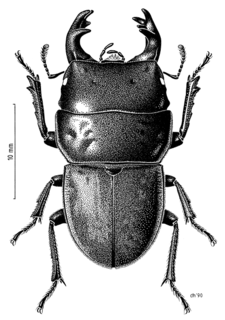
Geodorcus ithaginis, the Mokohinau stag beetle, is a large flightless species of stag beetle in the family Lucanidae. It was described by Thomas Broun in 1893 after being discovered in the Mokohinau Islands by Andreas Stewart Sandager, a lighthouse keeper on the islands. The species survives only on the small unnamed island "Stack H", in a patch of vegetation the size of a living room, and is in extreme danger of extinction.

Lyperobius huttoni is a New Zealand weevil found in alpine areas of the South Island and at sea level around the Wellington coast. It feeds only on speargrass (Aciphylla). Weevils from the endangered Wellington population have been translocated to predator-free Mana Island.

Lyperobius is a weevil genus in the subfamily Molytinae. Most Lyperobius species live in sub-alpine and alpine grassland, feeding on members of the family Apiaceae. Adults are active by day and feed on flowers, seeds, leaves and stems of the host plant. Larvae are found in the thick roots, rhizomes and soil surrounding the root system. All members of this genus are endemic to New Zealand. With the exception of L. huttoni and L. nesidiotes, all species are only found on the South Island.

Lyperobius clarkei is a flightless weevil found in alpine areas of Buller and Nelson in the South Island of New Zealand.
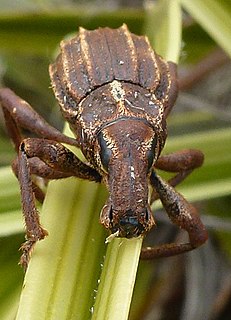
Anagotus oconnori or astelia weevil is a large flightless weevil found in New Zealand. It was first collected on Mount Quoin in Wellington from Astelia by Mr A.C. O'Connor after whom this species was named.
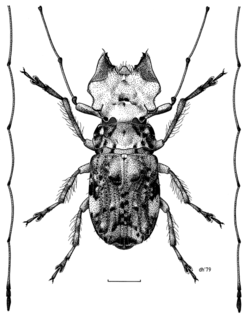
Hoherius meinertzhageni, the ribbonwood fungus weevil, is an endemic New Zealand beetle that has been recorded feeding on the ribbonwood species Plagianthus regius and Plagianthus divaricatus and the mountain lacebark, Hoheria glabrata.























